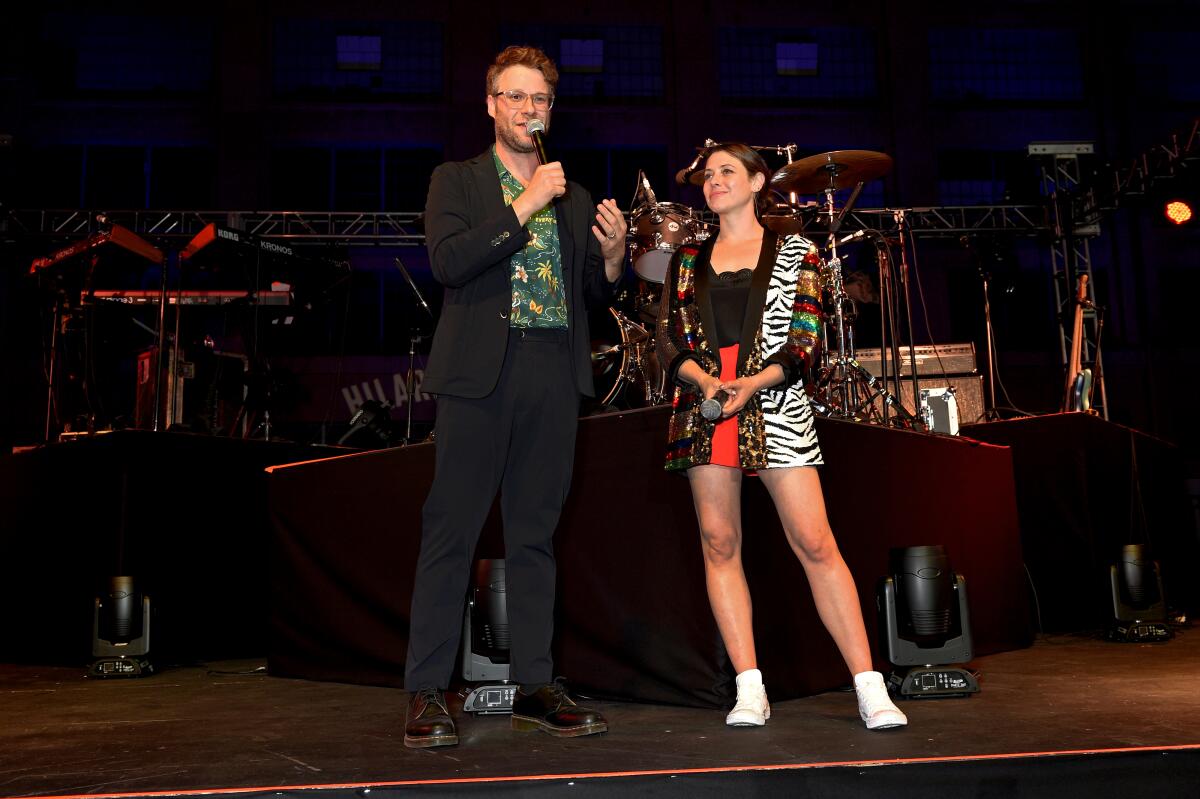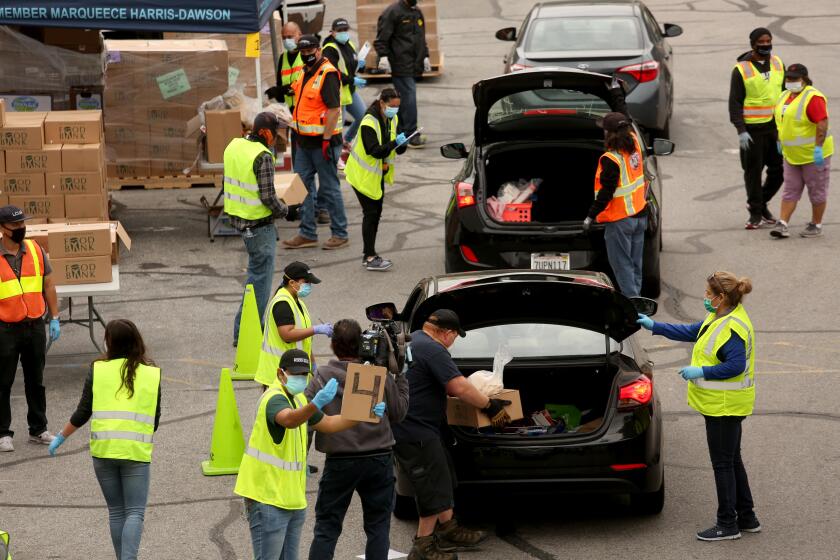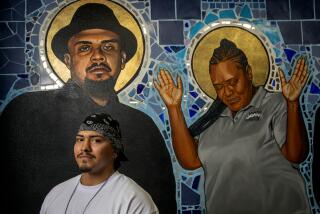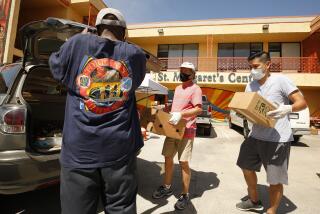Charities are getting creative during COVID-19. The unexpected ways some are staying afloat
Every day during October, 66-year-old Los Angeles resident Mitch Besser stepped outside to his Concept2 rowing machine, muscling out a total for the month of 500,000 meters, or nearly 311 miles.
Besser accomplished that feat — rowing an average of 10 miles each day — as part of a virtual fundraiser for Mothers2mothers, a charity he founded in 2001 when he was a doctor in South Africa to provide education and support for HIV-positive mothers and children. The organization usually raises money with a sponsored group bike ride, which every two years reaped as much as $250,000 and familiarized donors with the people and places helped by their contributions.
Perhaps fortunately, Besser had limited knowledge of the sport and no idea that on some days he was rowing 10 times the length of Olympic rowing events.
“I had nothing to compare it to. Sometimes, if you think too much, you never try,” said Besser, who kept himself on pace with music, including the Eurythmics’ “Would I lie to you?” — not a surprising choice given that he’s married to group member Annie Lennox. She rowed too.
“In any other situation rowing would seem like an absolutely ridiculous idea as a fundraiser,” said Emma France, global and strategic engagement director for Mothers2mothers. “But in these strange times are ideas that we have to consider and pursue.”
At-home volunteers raised $325,000 — more than the usual bike event — through rowing, plus additional remote fundraising through bicycling, walking and running. It’s a successful tale in an otherwise troubling year for many nonprofits.
Donors are giving heavily to organizations dealing with the novel coronavirus and its economic fallout — developing vaccines, improving treatment and supplying food and other necessities to those suddenly unemployed, for instance. The tally reached $16.5 billion this week for wealthy corporations, foundations and individuals, according to Candid, a nonprofit that tracks philanthropy.
Pandemic has spawned the greatest outburst of philanthropy in modern times, but it’s also highlighted America’s deep socioeconomic divisions.
But many other charities are struggling because the pandemic has shut down all in-person events. In addition, regular donors who aren’t wealthy but make small contributions may have lost work because of coronavirus-related restrictions and can no longer give.
The California Assn. of Nonprofits said that a third of its members have cut services by more than 50%. Nearly 4 in 10 nonprofits could close for lack of funding in the next three years, Candid has projected.
Nonprofits are responding with innovative ways to raise money, such as Mothers2mothers’ virtual feats of strength.

Hilarity for Charity put on an online game show for Alzheimer’s education, prevention and caregiver support. The Florence Immigrant & Refugee Rights Project hosted a remote documentary viewing party.
It doesn’t always work out. New Jersey-based JAR of Hope, for instance, had begun to raise funds for Duchenne muscular dystrophy research with an online raffle but had to stop after the state’s attorney general ruled that charities can’t operate remote raffles.
Here are four nonprofits that are finding a way during the pandemic.
Hilarity for Charity
The Santa Monica Pier was packed on a September day before the pandemic arrived in the U.S., with ticketholders lining up for rides and celebrity-run carnival games during Hilarity for Charity County Fair 2019.
It was a big fundraiser for the charity, which focuses on Alzheimer’s disease and helping people caring for a family member with the affliction. The nonprofit is a passion project for actor Seth Rogen and his wife, Lauren Miller Rogen, whose mother has Alzheimer’s.
This kind of event couldn’t be held in 2020 because of the surging pandemic, but the organization was already accustomed to gathering groups in a virtual setting.
“Our support group model has never been in person and has always been run through virtual meeting rooms,” Miller Rogen said. And so we’ve always known that people can come together in a really supportive way, digitally and virtually.”
Rogen said they brainstormed about “a virtual event that would be fun and exciting. And we came up with the idea of a virtual game show.”
The comedian hosted it in the gaudiest of suits — yellow, orange, brown and black plaid — and worked with teams led by actresses Anna Faris and Elizabeth Banks, and comedy vets Jim Gaffigan, Craig Robinson and Billy Eichner. The show was sponsored by biotech firm Biogen.
The game show raised about $325,000, which the Rogens said was roughly one-third to one-half the amount their typical in-person events bring in. But the big surprise was the size of the Zoom crowd that showed up, about 2,000 people from around the world, larger than the crowd at the Santa Monica Pier last year.
“I think we’ve seen that there are ways of bringing large groups of people together virtually that are very effective,” Rogen said, “And that doesn’t mean we replace in-person events, but I think we can simply add these types of things throughout the year. They’re fun and easy for people to commit to.”
Florence Immigrant & Refugee Rights Project
Despite the coronavirus outbreak, the Florence Immigrant & Refugee Rights Project has remained busy with services that include providing legal representation in immigration proceedings for detained adults and children and reuniting families.
The project helps asylum seekers hoping to settle in the U.S. Patricia, who asked that her last name not be used because she fears for her safety, was a refugee from Nicaragua, where she said she was persecuted for her support of the “blue and white movement” pro-democracy protests. The project helped her win asylum, and she now lives with an aunt in Florida.
The pandemic created new problems for the Arizona-based nonprofit to tackle.
“Arizona detention centers had the worst outbreaks in the country,” said Gabriela Corrales, the project’s director of philanthropy. “And so we sued multiple times for people to be released, especially the medically vulnerable. We are always pivoting because of COVID-19.”
A crucial pivot began in 2019 when, at the persistent and prophetic advice of their philanthropy consultant, the project’s leaders had started to back off from its busy calendar of in-person fundraisers, which can be expensive to put on, as a way to save money.
“We had an art show last year. We had a pro bono event where we had our attorneys attend from all across the state,” Corrales said. “We had planned this year to visit several cities. Instead, we’ve had to shift to virtual events, and that’s been a big change.”
When the Netflix documentary “Immigration Nation” premiered in July, the Florence Immigrant & Refugee Rights Project hosted an online viewing party for more than 70 donors, followed by a discussion of the film’s examination of the U.S. immigration system.
“We were also sharing how the numbers of detentions and family separations were climbing,” Corrales said. “We asked people to please keep sharing this information, keep talking about this because we don’t want people to forget.”
Online gatherings require few personnel, no venue, caterer and other event necessities. As a result, the net amount the project receives from donations is down just slightly compared with 2019, Corrales said.
No Kid Hungry
Bill Shore, executive chairman of No Kid Hungry, has an enviable pandemic problem: handling more funding from donations than the 10-year-old organization has ever seen by a factor of several million dollars.
By early November, No Kid Hungry had used the generosity to regift $34.5 million to more than 1,200 schools, food banks and community organizations, with plans to distribute an additional $28 million by the end of the year, said Shore, who founded the nonprofit.
“I think there was a moment early on in the pandemic when people were desperate to make some kind of difference,” Shore said.
“You couldn’t cure it. You couldn’t invent a vaccine. You couldn’t donate to a vaccine, really. So I think in some ways, we were the next best way for folks who felt like ‘I’ve got to do something, because this is so terrible.’”
When No Kid Hungry had to shift its message from in-person events, Shore found help from many sources.
“We’ve had the fitness trainer Isaac Calpito raising more than $1 million on his livestream workout every day, seven days a week, at 11 a.m. on Instagram. We had Broadway actors creating alternative theatrical events called the Homebound Project. They were livestream, one-person, one-actor short plays.”
Hollywood agent Richard Weitz and his teenage daughter, Demi, raised money for No Kid Hungry with the aptly named Quarantunes, which featured big names including John Mayer, Josh Groban and Boy George Zoom-casting from their homes.
“Every Saturday night, they were doing this very exclusive livestream invitation-only, password-protected event to raise money. One of those raised a really significant amount of money for us,” Shore said.
No Kid Hungry also had celebrities reading short stories streamed on various social media platforms, in partnership with Save the Children, to drive more interest in donating. The readers included actresses Lupita Nyong’o, Jennifer Garner and Amy Adams.
“We also, for the first time, launched a direct-response TV campaign that featured actor Jeff Bridges,” said Andrea Holliday, senior manager for national consumer media for No Kid Hungry and its parent organization, Share Our Strength.
Corporate donations came from Taco Bell, Williams-Sonoma, Verizon, NBCUniversal and others.
“The level of generosity has been astonishing,” he said, acknowledging that he was somewhat worried during the early days of the virus lockdowns, “but then the funds really just started to flow in. They haven’t stopped. They’ve slowed down, but they haven’t stopped.”
Mothers2mothers
Besser, who was rowing 10,000 to 20,000 meters a day by the end of the month, had prepared himself for the potential — perhaps even likelihood — of failure of his goal to convince volunteers to row 1 million meters for Mothers2mothers.
Besser, who has stepped in as interim chairman for the charity’s South Africa office, was counting on the organization’s track record: Creating more than 11,000 jobs for women living with HIV and providing services and education. Most important, women are giving birth to babies free of HIV, Besser said. Mothers2mothers gets half of its money from the U.S. government and has a budget of $25 million, Besser said.
But it was a bad time to be asking anyone for money, he thought, particularly for a cause involving a distant continent when there was so much to be done in the U.S. His fallback hope was just for “some proof of concept, that the idea might work,” he said.
He was wrong. Volunteers rowed more than 2.2 million meters for Mothers2mothers.
“We had 41 rowers altogether, aged 6 to 66, including my wife, Annie,” Besser said. “We had three Olympians who rowed for us. We had a U.K. team that belonged to a rowing gym called Rowbots.”
The effort was boosted by one of Britain’s most popular soccer players, who has a whopping 43.7 million followers on Instagram. Gareth Bale, a soccer player for Tottenham Hotspur, reached out to his followers and asked people to participate.
Despite the success of the remote events, the semiannual bicycle ride was sorely missed. This year was supposed to be in Uganda for five days in October.
“It’s more than just a ride,” Besser said. “We go to our sites, we meet the site staff. It’s half riding and half exposure to Mothers2mothers in the field. We always go to where we’re programming so that the riders can really feel what we’re doing.”
Besser said future fundraising probably will become a hybrid of live and virtual events.
“I imagine the beauty of being able to raise $200,000 to $300,000 every other year, and now we’re going to be able to do that every year,” Besser said. “The proof of concept worked very nicely.”
More to Read
Inside the business of entertainment
The Wide Shot brings you news, analysis and insights on everything from streaming wars to production — and what it all means for the future.
You may occasionally receive promotional content from the Los Angeles Times.












